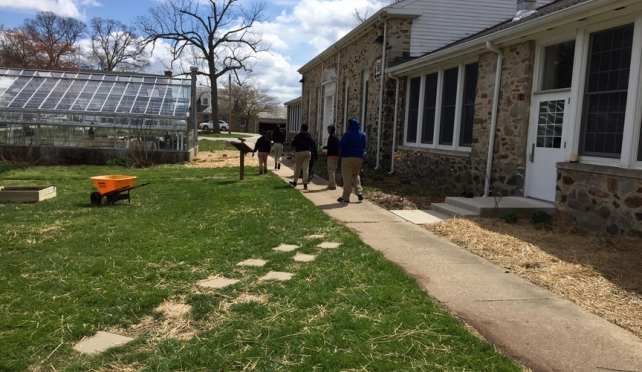By Christy Macy
On a beautiful spring day in March, 31 seventh graders from Arundel Middle School bound off the bus to get their first look at Great Kids Farm. Initially busy fooling around and looking at their cell phones, the students soon settle down as Farm Educator Beth Mathie welcomes them and describes what they will be doing in the next four hours. As participants in the Learning Journeys initiative, these middle schoolers – like 1,800 others this Spring – will experience firsthand the three different “roles” they play as producers, consumers, and composters that make up the growing cycle. Great Kids Farm created their Learning Journey initiative to provide a meaningful and uniform farm experience for every student during their City Schools education. The initiative aims to reinforce components of the 7th grade science curriculum by engaging students in a positive outdoor experience through the themes of sustainability and food production.
Divided into three groups, students set off on their learning experience across the Farm. My group is guided by GKF volunteer guide Frances Horich. “Do any of you garden?” she asks the students, directing them to a nearby field not yet prepared for planting. “I help my grandmother grow lettuce,” volunteers one student. None of the others have any similar experience. Frances describes how plants need soil, sunlight, water, and oxygen to live, and explains that the field they are looking at is currently growing a cover crop. It will be turned over in the next few weeks so those nutrients will be returned to the soil. “We are trying to be good stewards of the land, so it will endure,” Frances says. “To endure is to be sustainable. Who can spell sustainable? That’s a very important word for you to learn.”
When one student pulls out a lollypop, Frances seizes the opportunity to talk about healthy eating. “It’s pure sugar, which is not very healthy,” she explains. “It’s important that you know what you’re putting in your body and then make the right decisions.” Too much sugar can lead to diabetes, warns Frances, but corn syrup is even worse for you. “Look at the ingredients of what you buy at the store, including calories so you can be sure you are eating what’s good for you.”
After explaining that farmers need to be aware of the weather in terms of when and what to plant, Frances takes the group into the greenhouse. Even on this chilly day, the students begin peeling off their jackets as they examine the raised earth-filled boxes filled with sprouts of microgreens, radishes, spinach, and kale. “Greenhouses allow farmers to produce vegetables even in the middle of winter, through mid May.” After explaining the process of photosynthesis—collecting sunlight and turning it into food and energy—she tells the group that some of the microgreens they see here end up in high- end restaurants.
“Who likes Fig Newtons?” Frances asks as the group goes outside again. When a lot of hands shoot up, she explains that they are standing next to a fig tree.
Next stop is a classroom in the GKF main building, where Michelle Hollingsworth, who is working toward a master’s degree in nutrition, is displaying a range of fresh vegetables on her table. “You have just finished seeing what it takes to produce food, so this is the consumer part of your journey,” she says. The students lean forward to hear more. Michelle draws a circle diagram on the blackboard dividing food into the five groups: fruits, vegetables, grains, dairy, and protein. She explains that it’s important to be consuming all of them to be a healthy human being. “Try to make your plate look like a rainbow, so you know you’re getting a good array of food that includes all of these groups.” During most of the class, she distributes small helpings of vegetables and herbs to each student and getting their responses. This is clearly a fun session. Michelle tells the students how to cook vegetables like carrots or radishes, but that eating them raw, as they are doing, is the best way. “This is really spicy,” says one student after she bit into a radish. “The kale tastes like grass,” says another, and the group starts laughing. There was a general consensus that beets were sweet, but baby arugula tastes ‘sharp.’ Michelle encourages them to eat foods they have never tried before. “You might like it!” she says as she hands out a recipe for the ranch dressing she had made at the start of the class.
Before heading off to the composting session, some students volunteer what they’ve learned so far. There are a few grumbles that they had hoped to see some animals, but mostly the responses are positive. “I liked eating the vegetables,” says one. “Don’t use pesticides,” says another. “Corn syrup is even worse for you than sugar!” and “Drink eight glasses of water every day!” others shout. The most important word they learned? A few students chime in: “Sustainability.” I knew that would make Frances smile.


